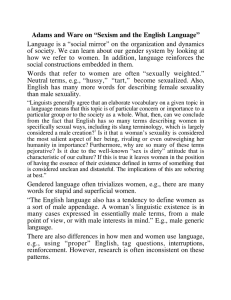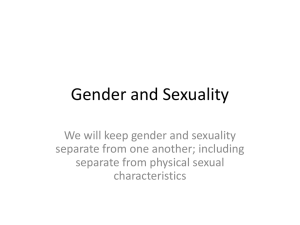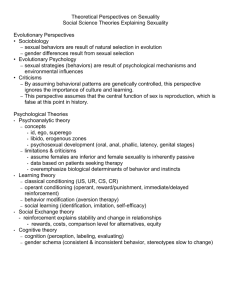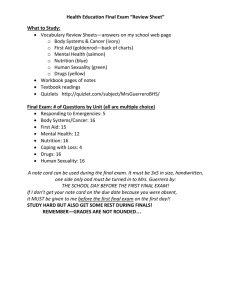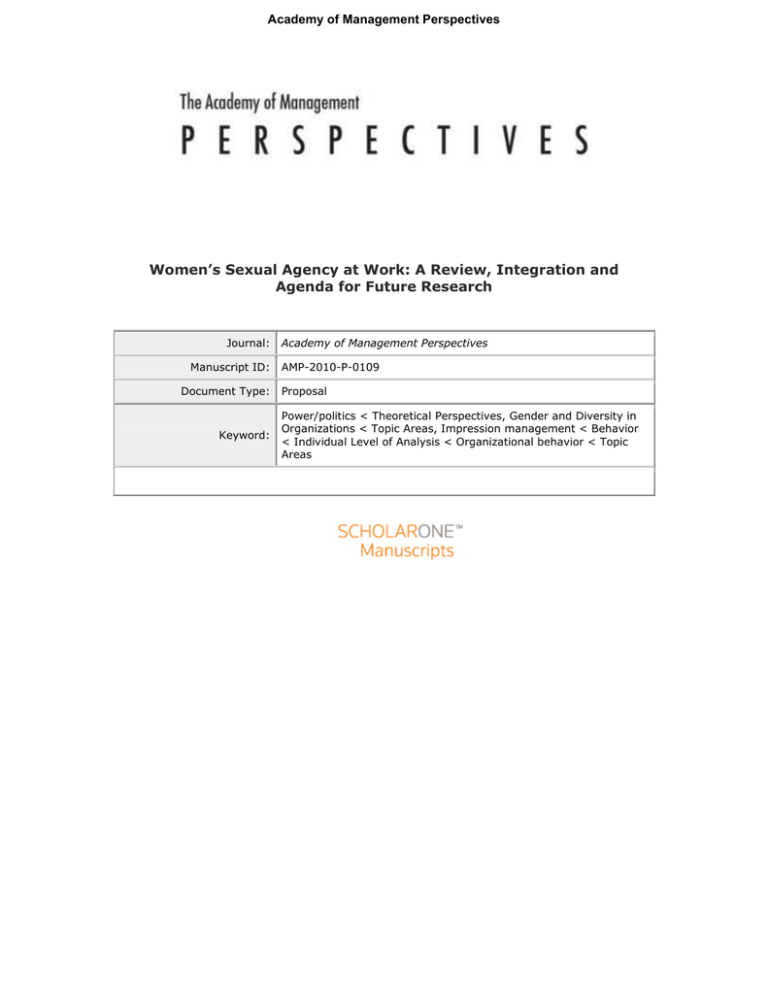
Academy of Management Perspectives
Women’s Sexual Agency at Work: A Review, Integration and
Agenda for Future Research
Journal:
Manuscript ID:
Document Type:
Keyword:
Academy of Management Perspectives
AMP-2010-P-0109
Proposal
Power/politics < Theoretical Perspectives, Gender and Diversity in
Organizations < Topic Areas, Impression management < Behavior
< Individual Level of Analysis < Organizational behavior < Topic
Areas
Page 1 of 6
1
2
3
4
5
6
7
8
9
10
11
12
13
14
15
16
17
18
19
20
21
22
23
24
25
26
27
28
29
30
31
32
33
34
35
36
37
38
39
40
41
42
43
44
45
46
47
48
49
50
51
52
53
54
55
56
57
58
59
60
Academy of Management Perspectives
Women’s Sexuality Review-1
Women’s Sexual Agency at Work: A Review, Integration, and Agenda for Future Research
“Enter most organizations and you enter a world of sexuality…this can include a mass of sexual
displays, feelings, fantasies, and innuendoes as part of everyday organizational life…”
- Hearn & Parkin, 1995, p 3
In addition to research that shows that a significant number of female workers have
participated in social-sexual behaviors (e.g., Salzinger, 1997), women’s expressions of sexuality
can damage or enhance their work relationships with male and female colleagues (e.g., Lerum,
2004), influence how they are perceived by others (e.g., Glick, Larsen, Johnson, & Branstiter,
2005), improve their personal well-being (e.g., Salzinger, 1997), and enhance or diminish their
work outcomes (e.g., Bradley, Chan, Brief, & Baskerville, 2005; Loe, 1996). We propose to review
and summarize the extant research addressing women’s expressions of sexuality at work to
explain (a) why some women express their sexuality at work and also (b) why some sexual
displays can be advantageous while others detrimental for the women who exhibit them. Our
review will consolidate and synthesize quantitative and qualitative research from different
disciplines, including sociology, psychology and management, to present an integrated model
(see Figure) of the antecedents, moderators, and consequences for women’s displays of sexuality
at work and to highlight fruitful avenues for future research as well as implications for
management practice. Interest in this area has surged over the past few decades (both in the
popular press and academic circles), but we are unaware of a systematic review that examines
women’s sexual behavior at work. The aim of our review is to fill this gap in the literature.
The scope of our review will include studies related to women’s sexuality at work that we
will organize to document the antecedents, moderators, and consequences of women’s sexual
behaviors at work. We restrict our analysis to women’s sexual agency, as opposed to men’s,
because the expressions of sexuality as well as the antecedents and consequences of these
behaviors likely differ for men and women. We intend for our review to be the catalyst for future
Academy of Management Perspectives
1
2
3
4
5
6
7
8
9
10
11
12
13
14
15
16
17
18
19
20
21
22
23
24
25
26
27
28
29
30
31
32
33
34
35
36
37
38
39
40
41
42
43
44
45
46
47
48
49
50
51
52
53
54
55
56
57
58
59
60
Women’s Sexuality Review-2
work on different forms of sexual behaviors at work from the perspective of women. Social
sexual behavior in our review will be defined as intentionally expressed behaviors and
expressions (here initiated by women) that have sexual implications, meanings, or goals. They
are not limited to acts of an intimate nature and can include behaviors that are directed towards
acquaintances, strangers, or even customers. We are excluding SH from our review because a
very small proportion of perpetrators of SH are women (O’Leary-Kelley et al., 2009) and also,
SH may have less to do with sexuality per se and more to do with power/reactions to identity
threats (see Berdahl, 2007). However, we do consider SH as one of the potential negative and
unintended consequences of women’s social sexual behavior. Woman can express their sexuality
through their appearance, verbal and nonverbal communications, and behaviors, including, but
not limited to, flirting and wearing seductive clothing. These expressions may be designed to
elicit the sexual desires of others, to demonstrate or feign the woman’s own sexual desires, or
simply to express a personal style or behavioral preference as defined by the woman.
In the first part of our paper, we review research on the factors that explain why women
express their sexuality at work. For example, women have been found to express their sexuality
at work because it is directly related to the requirements or expectations of their job (Gutek &
Morasch, 1982) such as with retailers (Hanser, 2005), strippers (e.g., Price, 2008; Trautner,
2005); flight attendants (e.g., Hochschild, 1983; Mills, 2006), waitresses (e.g., Lerum, 2004;
Loe, 1996) and secretaries (e.g., Pringle, 1989). Further, because sexuality has been construed as
a more valuable resource than male sexuality, women are more likely in the position of ‘selling’
sex to attain desired resources (Baumeister & Vohs, 2004). Thus, women who have less power
may be motivated to use their sexuality as an influence tactic. Our next section reviews research
on the consequences of women’s expressions of sexuality, which has suggested both positive and
Page 2 of 6
Page 3 of 6
1
2
3
4
5
6
7
8
9
10
11
12
13
14
15
16
17
18
19
20
21
22
23
24
25
26
27
28
29
30
31
32
33
34
35
36
37
38
39
40
41
42
43
44
45
46
47
48
49
50
51
52
53
54
55
56
57
58
59
60
Academy of Management Perspectives
Women’s Sexuality Review-3
negative outcomes. Our review will fully examine the career, personal and interpersonal costs
and benefits (e.g. access to networks, receipt of work-related favors) that accrue to women who
express their sexuality at work. In the third section of our paper, we review research examining
individual and contextual factors that may influence the relationship between women’s
expressions of sexuality and outcomes. For example, organizations or industries that are maledominated (e.g., Ely, 1995), service-oriented (e.g., Hall, 1993), or sexually charged (e.g., Loe,
1996) may not only determine the enactment of sexual workplace behaviors, but also how others
react and whether such behavior is positively or negatively evaluated.
A theoretical contribution of our model is that it synthesizes findings from different
disciplines into a general framework from which testable hypotheses can be derived. Also, given
that very little is known about why some women decide to express their sexuality while others
choose not to, the model presents possible moderators that might explain these differences. A
practical contribution of our model is that it can help offer female employees and managers more
insight into how their behaviors may influence others and have implications for their personal
and organizational outcomes. At the same time, it directs male employees’ and managers’
attention to the roles that they might play in maintaining cultures or social structures in which
these behaviors can produce undesirable effects. The relevance of, and interest in, this review on
women’s sexual agency at work are far-reaching given its interdisciplinary roots. Thus, we
expect the review, theoretical model, and directions for future research to appeal to scholars in
various areas (e.g., gender, politics, human resource policy and practice) as well as the nonspecialist academic reader due to the nature of the behavior being explained. Further, this article
should be germane to any management class that covers material relating to organizational
behavior, power and politics, and human resource management.
Academy of Management Perspectives
1
2
3
4
5
6
7
8
9
10
11
12
13
14
15
16
17
18
19
20
21
22
23
24
25
26
27
28
29
30
31
32
33
34
35
36
37
38
39
40
41
42
43
44
45
46
47
48
49
50
51
52
53
54
55
56
57
58
59
60
Women’s Sexuality Review-4
References
Berdahl, J. L. 2007. Harassment based on sex: Protecting social status in the context of gender
hierarchy. Academy of Management Review, 32: 641-658.
Bradley, J., Chan, S., Brief, A. P., & Baskerville, M. 2005. Sex as a tool: Does utilizing sexuality
at work work? Annual Meeting of the Academy of Management, Honolulu, HI.
Glick, P., Larsen, S., Johnson, C., & Branstiter, H. 2005. Evaluations of sexy women in low-and
high status jobs. Psychology of Women Quarterly, 29: 389-395.
Gutek, B. A., & Morasch, B. 1982. Sex-ratios, sex-role spillover, and sexual harassment of
women at work. Journal of Social Issue, 38: 55-74.
Hall, E.J. 1993. Smiling, deferring, and flirting: Doing gender by giving good service. Work &
Occupations, 20: 452-471.
Hanser, A. 2005. The Gendered Rice Bowl: The Sexual Politics of Service Work in Urban
China. Gender and Society, 19(5): 581-600.
Hochschild, A. 1983. The managed heart: Commercialization of human feeling. Berkeley:
University of California Press.
Lerum, K. 2004. Sexuality, power, and camaraderie in service work. Gender & Society, 18(6):
756-776.
Loe, M. 1996. Working form men: At the intersection of power, gender, and sexuality.
Sociological Inquiry, 66(4): 399-421.
Mills, A. J. 2006. Sex, strategy, and the stratosphere: Airlines and the gendering of
organizational culture. New York: Palgrave Macmillan.
Page 4 of 6
Page 5 of 6
1
2
3
4
5
6
7
8
9
10
11
12
13
14
15
16
17
18
19
20
21
22
23
24
25
26
27
28
29
30
31
32
33
34
35
36
37
38
39
40
41
42
43
44
45
46
47
48
49
50
51
52
53
54
55
56
57
58
59
60
Academy of Management Perspectives
Women’s Sexuality Review-5
O’Leary-Kelly, A. M., Bowes-Sperry, L., Bates, C. A., & Lean, E. R. 2009. Sexual Harassment
at Work: A Decade (Plus) of Progress. Journal of Management, 35: 503-536.
Pringle, R. 1988. Secretaries talk: Sexuality, power, and work. London: Verso.
Salzinger, L. 1997. From high heels to swathed bodies: Gendered meanings under production in
Mexico's export-processing industry. Feminist Studies, 23(3): 549-574.
Trautner, M. N. 2005. Doing gender, doing class: The performance of sexuality in exotic dance
clubs. Gender & Society, 19: 771-788.
Academy of Management Perspectives
1
2
3
4
5
6
7
8
9
10
11
12
13
14
15
16
17
18
19
20
21
22
23
24
25
26
27
28
29
30
31
32
33
34
35
36
37
38
39
40
41
42
43
44
45
46
47
48
49
50
51
52
53
54
55
56
57
58
59
60
Page 6 of 6
Women’s Sexuality Review-6
Figure 1
Model of Women’s Expressions of Sexuality in Organizations
nnn
Antecedents
Women’s Expressions
of Sexuality
Demographic
Characteristics of the
woman (e.g., age, marital
status)
Position/Power
Industry
Characteristics of the
Organization
Flirting
Provocative Attire
Sexual
Mannerisms
Moderators
Demographic Characteristics
of the woman (age, race,
marital status)
Organizational Culture (e.g.,
sexualized environment)
Male vs. Female dominated
Consequences (positive and/or
negative)
(+; -) Well-being
( -) Sexual Harassment (of the
woman)
(+; -) Relationships with men
(+; -) Relationships with
women



